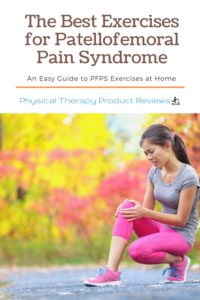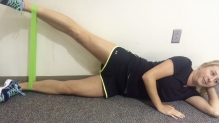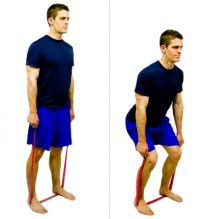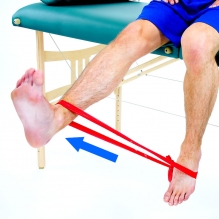Your knees help you do a lot of things, like kneeling to pick something up or climbing a set of stairs. If our legs didn’t have knees, we couldn’t do things as simple as sitting down! It’s easy to forget all the things healthy knees do for you until you start experiencing pain. Then the reality of how often you use your knees becomes quite apparent.
 One of the most common forms of knee pain is classified as Patellofemoral Pain Syndrome. This can be a very limiting condition and causes a person a great deal of discomfort. Luckily, there are some proven ways to treat it.
One of the most common forms of knee pain is classified as Patellofemoral Pain Syndrome. This can be a very limiting condition and causes a person a great deal of discomfort. Luckily, there are some proven ways to treat it.
What is Patellofemoral Pain Syndrome?
 Patellofemoral Pain Syndrome, also known as PFPS, is a frequently issued diagnosis for patients with pain around the knee cap. It’s considered an overuse injury, though it doesn’t just affect people who exercise. This condition is seen in both active and sedentary people alike.
Patellofemoral Pain Syndrome, also known as PFPS, is a frequently issued diagnosis for patients with pain around the knee cap. It’s considered an overuse injury, though it doesn’t just affect people who exercise. This condition is seen in both active and sedentary people alike.
Most people will experience pain and discomfort while completing specific activities or feel pressure on the kneecap. This is a condition that can greatly limit a person’s abilities in daily life and recreation. It can also last for a very long time if it isn’t properly treated.
The Symptoms of Patellofemoral Pain Syndrome
The pain associated with PFPS is vague yet relentless. Lacking any specific focal point, the most common location of the pain is in front of and behind the knee cap. Symptoms can begin suddenly or develop slowly over time.
The most aggravating activities are usually any combination of the following.
- Squatting
- Kneeling
- Climbing stairs
- Sitting too long with the knees bent
- Running
- Walking/running up and down hills
People with PFPS can experience pain in front of the knee, stiffness in the joint, and even some popping or clicking around the kneecap.
Symptoms can affect a person’s ability to play sports, exercise, or even complete daily activities. PFPS can be a very limiting condition and, unfortunately, isn’t one that will spontaneously improve. For this reason, it’s important to seek out care from a Physical Therapist when symptoms begin to affect your quality of life.
Populations at Risk
PFPS is found across all age ranges and fitness abilities. Most commonly, it’s seen in young adults and teenagers, with the majority of those affected being women. The population most at risk for developing PFPS are physically active women.
There are no other known physical characteristic risk factors for PFPS, as it affects so many different kinds of people. It is known that people with PFPS also have weak thigh and hip muscles. These weaknesses can lead to muscular imbalances and poor alignment of the hip and knee, which may overload the knee joint during functional activities.
With this knowledge, we can see how PFPS is classified as an overuse injury. It also has a high rate of recurrence and can easily transition into a chronic condition. The good news is that the quicker you deal with your symptoms, the less likely they’ll be to return in the future.
Exercises to Help with Patellofemoral Pain Syndrome
It’s best to perform a combination of knee and hip exercises to achieve the best results in treating PFPS related pain.
The main focus should be on strengthening the hip, as research tells us that this is where the most weakness typically lies.
To maximize benefits and to do your exercises are home we recommend getting an inexpensive mini band set. Our favorite is the Perform Better mini Bands.
Hip Extension
- Loop a resistance band around your knees.
- Stand up tall and hold onto something in front of you (like a chair or table) if you need help to balance.
- Lift your leg behind you, moving from the hip, and keeping your knee straight. You should feel a contraction in your glute muscles.
- Hold for a second or two, then return to standing.
- To advance the exercise, lower the resistance band to your ankles.
- Complete 3 sets of 15 reps on each leg.

Lateral Leg Raises
- Lay on your side and loop a resistance band around your knees.
- Keep your hips and knees stacked on top of each other.
- With control, raise your top leg a few feet, hold for several seconds, then slowly lower back down.
- Try to lead with your heel, and keep your toes pointing straight ahead.
- To advance the exercise, lower the resistance band to your ankles.
- To make this exercise easier, remove the resistance band altogether.
- Complete 3 sets of 12 on each leg.

Bridges
- Lay on your back with your feet planted on the ground and your knees bent.
- Tighten your core and contract your glutes to lift your hips.
- Aim to get your body in a straight line from shoulders, to hips, to knees. Don’t let your knees splay out to the side.
- Hold, then lower slowly back down.
- To advance this exercise, loop a resistance band around your knees.
- Complete 2 sets of 15 reps.

Resisted Squats
- While standing, hold a resistance band end in each hand, then step down on the middle of the band.
- Position your feet about hip-distance apart.
- Keep your back straight and lower down into a squat.
- Ensure that your knees don’t buckle in or extend beyond your toes.
- Return to stand.
- Complete 3 sets of 12 reps.

Resisted Knee Extension
- Sit in a chair with your knees bent and feet in contact with the ground.
- Loop a resistance band around your ankles.
- Keep one leg stationary and contract the opposite quad to extend the other leg out straight.
- Hold for a few seconds, then slowly lower back down.
- Complete 2 sets of 15 exercises on each leg.
** This exercise might cause some soreness, and that’s ok. But if it hurts, you can hold off for now

More on Patellofemoral Pain Syndrome?
Tips for Reducing Knee Pain
Take it Easy
To start, reduce your activities and try to avoid things that aggravate your pain. It’s important to include a period of rest before attempting to build back up to your activity level or normal habits.
Use a Brace to Back To Activities
One of the best ways to get back to activities such as biking or walking sooner is to try a knee brace that controls the patella tracking. See our helpful guide on the best patella tracking braces.
Try Foot Orthotics
You can use foot orthotics in your shoes to help support your arch, which can aid in providing good alignment for your legs. Icing and light massage to the painful areas can deliver a degree of immediate relief.
Begin Some Light Stretching
If your knee feels stiff, try some light stretching like the quad, groin, and hamstring stretch. Start incorporating the exercises mentioned above and listen to your pain. Things might feel sore when you start an activity, but it shouldn’t cause a significant increase in pain.
Get Professional Help
After trying exercises and pain-reducing tips on your own, you may not see enough improvement in your symptoms. If this is the case, seeing a Physical Therapist can be immensely beneficial by providing you with a personalized treatment plan and guiding you through your rehabilitation for a gradual return to activity.
Key Takeaways
PFPS is a common condition that is frequently seen among patients reporting knee pain. Though it can be tricky to deal with, there are some evidence-based methods you can employ like the suggestions above. These tips and exercises can greatly help reduce your pain and get you back to normal!
Works Referenced:
Other Great Health Related Articles
GLP Weight Loss and Back Health: Effective Strategies and Insights
How to Stay Active After Cervical Fractures: Expert Tips and Advice
Dealing with Painful Stairs After Ankle Replacement Surgery
Walking After a Total Ankle Replacement: Tips for a Successful Recovery
Exercises While Non-Weight Bearing After Ankle Replacement: Elevation, AROM, Leg Raises, and More
Ankle Pain with Stairs: Causes and Home Treatment Options
Disclaimer: The information provided in this post is for educational purposes only. This is not a substitute for a medical appointment. Please refer to your physician before starting any exercise program.







